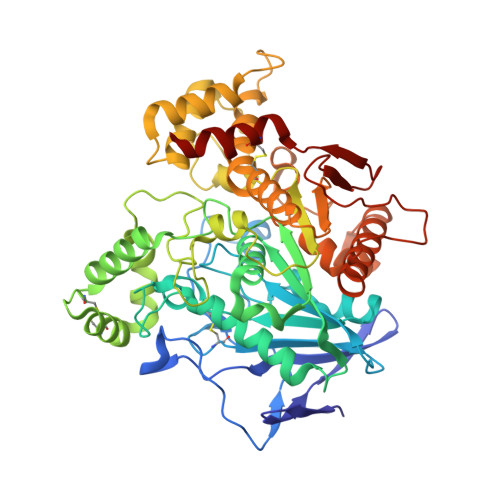Highly selective butyrylcholinesterase inhibitors related to Amaryllidaceae alkaloids - Design, synthesis, and biological evaluation.
Pidany, F., Kroustkova, J., Al Mamun, A., Suchankova, D., Brazzolotto, X., Nachon, F., Chantegreil, F., Dolezal, R., Pulkrabkova, L., Muckova, L., Hrabinova, M., Finger, V., Kufa, M., Soukup, O., Jun, D., Jenco, J., Kunes, J., Novakova, L., Korabecny, J., Cahlikova, L.(2023) Eur J Med Chem 252: 115301-115301
- PubMed: 36996715
- DOI: https://doi.org/10.1016/j.ejmech.2023.115301
- Primary Citation of Related Structures:
8CGO - PubMed Abstract:
Butyrylcholinesterase (BChE) is one of the most frequently implicated enzymes in the advanced stage of Alzheimer's disease (AD). As part of our endeavors to develop new drug candidates for AD, we have focused on natural template structures, namely the Amaryllidaceae alkaloids carltonine A and B endowed with high BChE selectivity. Herein, we report the design, synthesis, and in vitro evaluation of 57 novel highly selective human BChE (hBChE) inhibitors. Most synthesized compounds showed hBChE inhibition potency ranging from micromolar to low nanomolar scale. Compounds that revealed BChE inhibition below 100 nM were selected for detailed biological investigation. The CNS-targeted profile of the presented compounds was confirmed theoretically by calculating the BBB score algorithm, these data were corroborated by determining the permeability in vitro using PAMPA-assay for the most active derivatives. The study highlighted compounds 87 (hBChE IC 50 = 3.8 ± 0.2 nM) and 88 (hBChE IC 50 = 5.7 ± 1.5 nM) as the top-ranked BChE inhibitors. Compounds revealed negligible cytotoxicity for the human neuroblastoma (SH-SY5Y) and hepatocellular carcinoma (HepG2) cell lines compared to BChE inhibitory potential. A crystallographic study was performed to inspect the binding mode of compound 87, revealing essential interactions between 87 and hBChE active site. In addition, multidimensional QSAR analyses were applied to determine the relationship between chemical structures and biological activity in a dataset of designed agents. Compound 87 is a promising lead compound with potential implications for treating the late stages of AD.
Organizational Affiliation:
Department of Pharmacognosy and Pharmaceutical Botany, Faculty of Pharmacy in Hradec Kralove, Charles University, Akademika Heyrovskeho 1203, 500 05, Hradec Kralove, Czech Republic.






















